-
PARTS & ACCESSORIES
-
Nozzles

Blasting Chart /Nozzle Sizes/ How much air do I need? (PDF Reference Document)
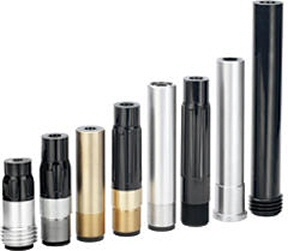
Venturi Nozzles
Long venturi style nozzles yield about a 40% greater production rate than straight bore nozzles. The internally tapered design of the venturi nozzle accelerates and evenly distributes the abrasive over the entire blast pattern.
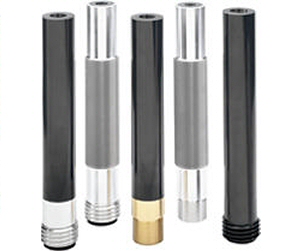
Special Venturi Nozzles
The XL Performance nozzles increase abrasive particle velocity, resulting in improved production rates and efficiencies. The XL Performance nozzles will utilize the same air (CFM) requirements as our standard long venturi products for the same given bore size, resulting in lower compressed air operating costs per square foot / meter. These products are produced in our popular lightweight BP200 SiAlON material, helping minimize nozzle weight and overall operator fatigue.
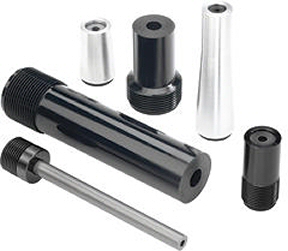
Straight Bore Nozzles
Straight bore nozzles are made for close range spot blasting. With small blast patterns and little overblast, they are good for cleaning small areas: weldments, grillwork, and railings.
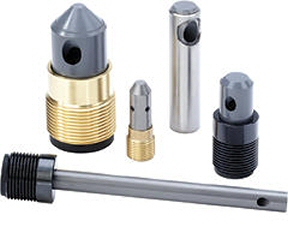
Angle Nozzles
These nozzles are excellent for getting inside tight places like bridge lattice, behind flanges, or inside pipe. Many operators waste abrasive and time waiting for ricochet to get the job done.
No nozzle tool chest should be without an angle nozzle. These nozzles are available in tungsten carbide, boron carbide, and ROCTEC® featuring long life blast outputs between 0o and 125o relative to the input openings. Available with single, double, triple, or quadruple outlets.
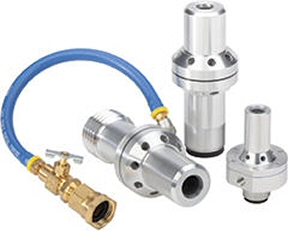
Wet Blast Nozzles
The WIN® (Water Induction Nozzle) system is a simple, cost effective solution for high production, wet abrasive blasting that can be used with your existing pressure blast equipment. The system can be used with water from a tap or with rust inhibitors introduced through any simple pump. No special equipment is required. The WIN® system offers the highest performance possible in wet abrasive blasting technology.
There are several sizes of WIN® system nozzles available in either tungsten carbide or BP200 SiAlON liners, with either metric or American threads. All of these nozzles use a standard 1″ I.D. blast hose and all can be used as a wet or dry blast nozzle. Water consumption with these nozzles is much less than with other wet blast systems, only 3/4 to 6 quarts per minute depending on the level of dust suppression desired.
Choosing the right blast nozzle for each application is simply a matter of understanding the variables that affect cleaning performance and job costs.
Figure 1:
1- Straight Bore
2- Conventional design long venturi
3- Laminar flow design long venturi
4- Double venturi
5- High pressure

There are four basic questions to answer for optimum cost/performance:

1.) What blast pattern do you want? A nozzle’s bore shape determines its blast pattern. Nozzles generally have either a straight bore or a restricted venturi bore. Straight Bore nozzles (Figure 1, Number 1) create a tight blast pattern for spot blasting or blast cabinet work. These are best for smaller jobs such as parts cleaning, weld seam shaping, cleaning handrails, steps, grillwork, or carving stone, and other materials. Venturi bore nozzles (Figure 1, Numbers 2 and 3) create a wide blast pattern and increase abrasive velocity as much as 100% for a given pressure. Venturi nozzles are the best choice for greater productivity when blasting larger surfaces. Long venturi style nozzles like the BRUISER® blasting nozzles, for example, yield about a 40% increase in productivity compared to straight bore nozzles, while abrasive consumption can be cut approximately 40%. Double venturi and wide throat nozzles are enhanced versions of the long venturi style nozzle. The double venturi style (Figure 1, Number 4) can be thought of as two nozzles in a series with a gap and holes in between to allow the insertion of atmospheric air into the downstream segment of the nozzle. The exit end is also wider than a conventional nozzle. Both modifications are made to increase the size of the blast pattern and minimize the loss of abrasive velocity.
Wide throat nozzles (Figure 1, Number 5) feature a large entry throat and a large, diverging exit bore. When matched with the same sized hose they can provide a 15% increase in productivity over nozzles with a smaller throat. When wide throat nozzles also feature a larger diverging exit bore (e.g., BAZOOKA® nozzle), they can be used at higher pressures to yield up to a 60% larger pattern with lower abrasive use. It’s also a good idea to have angle nozzles available for tight spots like bridge lattice, behind flanges, or inside pipes. Many operators waste abrasive and time waiting for ricochet to get the job done. The little time it takes to switch to an angle nozzle is always quickly recovered and total time on the job is reduced.
2.) Can your compressed air supply support the nozzle? As a general rule, the air supply system should be able to provide at least 50% more air volume (cfm) than a new nozzle would need to develop the required working blasting pressure, whether that is 100 psi or 140 psi. This ensures a nozzle can continue to provide good service even after it is slightly worn. Remember, though, excessive wear should not be allowed because productivity decreases dramatically. Keep in mind, too, the nozzle entry throat must match the inside diameter of your air supply hose. The wrong size combination can lead to wear points, pressure drop, and excessive internal turbulence.

3.) What bore size do you need? For maximum productivity, select the nozzle bore size based on the desired blast pressure and the available air pressure and flow. For example, assume you are running a 375 cfm compressor at 80% capacity. In addition to the blast cleaning nozzle, the compressor is supplying air to an air helmet and other components such as air motors and pneumatic controls, leaving 250 cfm available for the nozzle. 250 cfm is sufficient for a 7/16″ nozzle operating at 100 psi. A larger nozzle, or a worn 7/16″ nozzle, will require more air flow to maintain 100 psi. This extra flow requirement will either overwork your compressor or decrease productivity. On the other hand, choosing a nozzle with a bore smaller than your compressor can supply will result in less than maximum productivity from the system.

4.) What are the best nozzle material choices? Nozzle material selection depends on the abrasive you choose, how often you blast, the size of the job and the rigors of the job site. Here are general application guidelines for various materials. Aluminum oxide “alumina” (ceramic) nozzles offer good service life at a lower price than other materials discussed here. They are a good choice in low usage applications where unit price is a primary factor and nozzle life is less important. Tungsten carbide nozzles offer long life and economy when rough handling can’t be avoided and mineral or coal slag abrasives are used. All tungsten carbide nozzles are not equal. Note that all our tungsten carbide nozzles feature top wear grade material and durable construction. BP200 SiAION nozzles offer service life and durability similar to tungsten carbide, but these nozzles are only about half the weight of tungsten carbide nozzles. BP200 SiAION nozzles are an excellent choice when operators are on the job for long periods and prefer a lightweight nozzle. Boron carbide nozzles provide long life with optimum air and abrasive use. Boron carbide is ideal for aggressive abrasives such as aluminum oxide and selected mineral aggregates when rough handling can be avoided. Boron carbide will typically outwear tungsten carbide by five to ten times. ROCTEC® composite carbide nozzles provide even longer life than that of boron carbide nozzles. We currently offer two grades of this popular “binderless” tungsten carbide hard material: ROCTEC® 100 and ROCTEC® 500. This nozzle material is ideal for applications using aggressive abrasives like aluminum oxide and silicon carbide. Special angle nozzles, industrial gun inserts for the polular styles, etching nozzles, and pencil blast nozzles are a few of the special types of nozzles currently available. Not all current nozzle styles are available in ROCTEC®, however, new ROCTEC® nozzle styles are being added every day so check with us when you have precision requirements in blasting, drilling, or cutting.
When wet blasting is a requirement: There are three options when wet blasting is required or desired. First is a “water ring” attachment for standard blast nozzles that forces water on the blast stream as it exits the nozzle. While inexpensive, this option uses a lot of water and reduces the size of the blast pattern and the energy of the blast stream, cutting productivity up to 50%. Second is a water injection system that uses a high pressure pump to get water into the abrasive and air stream. Not only does this type of system add considerable cost and mechanical complexity, it slows air stream velocity and requires as much as six gallons of water per minute. The third option is the WIN® water induction system. The WIN® system uses a unique nozzle configuration that takes advantage of the venturi principle to draw or induct water from a low pressure line into the abrasive and air stream. This method is much simpler than a water injection system, effective, and water consumption is reduced from up to six gallons per minute to not more than several quarts…usually less. By reducing water use you increase abrasive velocity and work speed. You enjoy a larger blasting pattern for greater production rates since WIN® nozzles incorporate a considerably larger orifice than conventional nozzles. You also gain flexibility since the WIN® system can also operate with air only for blowdown applications or with an air/water mix for rinsing applications.
About JH Norton Company, Inc.
We are a premier stocking distributor for the leading manufacturers of surface preparation, dust collection, and industrial vacuum equipment and product lines. We are also leaders in the industry for newer technologies such as Sponge Blasting, Automation. Robotics and Laser Ablation technologies.
Norton Sandblasting Equipment is now JH Norton Company, Inc.
Dedicated to meeting your blasting and surface preparation needs with quality equipment, parts and supplies since 1973
Be sure to visit JH Norton Company, Inc. on Facebook.
Also, see Buy sandblasting equipment, parts, and accessories online.


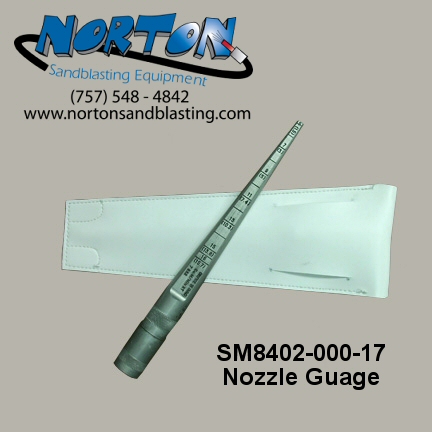 Nozzle Gauge- Check your nozzle’s size / wear
Nozzle Gauge- Check your nozzle’s size / wear